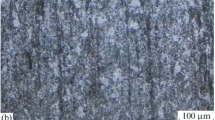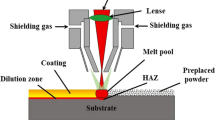Abstract
The cobalt-based alloy coating with different Co contents was deposited on 45 steel by electro-spark deposition with the self-made electrode. The coating has a compact and uniform microstructure with low porosity and no visible microcracks. When Co content increases gradually, oxygen content of coating samples 1–5 decreases first and then increases in the range of 2.52 wt%–3.05 wt%; sample 3 has the lowest oxygen content of 2.52 %. Microhardness of the coating is improved remarkably compared with the substrate (HV 230.18). With Co content increasing, microhardness of the coating samples 1–5 first rises slightly and then declines rapidly in the range of HV 580.61–1052.33. Sample 3 gets the maximum of HV 1052.33, which is about 4.6 times that of the substrate. The coating presents excellent wear resistance, which first increases and then decreases when Co content increases. Sample 3 shows the best wear resistance of about 6.4 times that of the substrate. Main wear mechanism of the coating is abrasive wear and fatigue wear, along with oxidation wear under high speed or heavy load conditions.
Graphical abstract
Cobalt content has an obvious influence on microhardness and tribological properties of cobalt-based alloy coating. When the cobalt content increases, the microhardness and wear resistance of the coating increase firstly and then decrease, the friction coefficient of the coating decreases firstly and then increases.








Similar content being viewed by others
References
Birol Y. Inconel 617 and Stellite 6 alloys for tooling in thixoforming of steels. Trans Nonferrous Met Soc China. 2010;20(9):1656.
Jin G, Xu BS, Wang HD, Li QF, Wei SC. Microstructure and wear resistance of electro-thermal explosion sprayed Stellite coating used for remanufacturing. J Cent South Univ Technol. 2005;12(S2):207.
Wang JS, Meng HM, Yu HY, Fan ZS, Sun DB. Wear characteristics of spheroidal graphite roll WC-8Co coating produced by electro-spark deposition. Rare Met. 2010;29(2):174.
Pan L, Gao WZ, Tao XQ, Xia CH. Evaluation on microtructures and properties of laser cladding layer for WFLC-11 Co-based alloy. Rare Met Mater Eng. 2007;36(8):1444.
Pang CS, Luo J, Guo ZM. Microstructure and properties of ultrafine WC-10Co composites with chemically doped VC. Rare Met. 2011;30(2):183.
Wang MC, Wang WF, Xie YJ, Zhang J. Electro-spark epitaxial deposition of NiCoCrAlYTa alloy on directionally solidified nickel-based superallo. Trans Nonferrous Met Soc China. 2010;20(5):795.
Dolinšek S, Tušek J, Kampuš Z. Electrospark deposition (ESD) for surfacing of direct metal laser sintering (DMLS) tools. In: 12th International scientific conference on achievements in mechanical & materials engineering, Gliwice, 2003: 1103.
Radek N. Experimental investigations of the Cu-Mo and Cu-Ti electro-spark coatings modified by laser beam. Adv Manuf Sci Technol. 2008;32(2):53.
Brochu M, Portillo JG, Milligan J, Heard DW. Development of metastable solidification structures using the electrospark deposition process. Open Surf Sci J. 2011;3:105.
Verbitchi V, Ciuca C, Cojocaru R. Electro-spark coating with special materials. Nonconv Technol Rev. 2011;15(1):57.
Sartwell BD, Legg KO, Price N, Aylor D, Champagne V, Pepi M, Pollard T. Electrospark deposition for depot-and field-level component repair and replacement of hard chromium plating: department of defense. Environmental Security Technology Certification Program (ESTCP). Washington, DC; 2006.
Chen Z, Zhou Y. Surface modification of resistance welding electrode by electro-spark deposited composite coatings: part I. Coat charact Surf Coat Technol. 2006;201(3–4):1503.
Evgeny AL. Development of electro-spark alloying (ESA) and thermo-reactive electro-spark surface strengthening (TRESS) technologies and set of equipment with attachments for mechanization. Moscow State Institute of Steel and Alloys (Technological University). Moscow; 2006.
Tušek J, Kosecl L, Lešnjak A, Muhič T. Electrospark deposition for die repair. Metalurgija. 2012;51(1):17.
Li ZW, Gao W, He YD. Protection of a Ti3Al-Nb alloy by electro-spark deposition coating. Scripta Materialia. 2001;45(9):1099.
Tang SK, Nguyen TC, Zhou Y. Materials transfer in electro-spark deposition of TiCp/Ni metal-matrix composite coating on Cu substrate. Weld J. 2010;89(8):172.
Acknowledgments
This project was financially supported by the National Natural Science Foundation of China (No. 50875261).
Author information
Authors and Affiliations
Corresponding author
Rights and permissions
About this article
Cite this article
Jing, QF., Tan, YF. Tribological properties of cobalt-based alloy coating with different cobalt contents by electro-spark deposition. Rare Met. 32, 40–46 (2013). https://doi.org/10.1007/s12598-013-0007-3
Received:
Revised:
Accepted:
Published:
Issue Date:
DOI: https://doi.org/10.1007/s12598-013-0007-3




